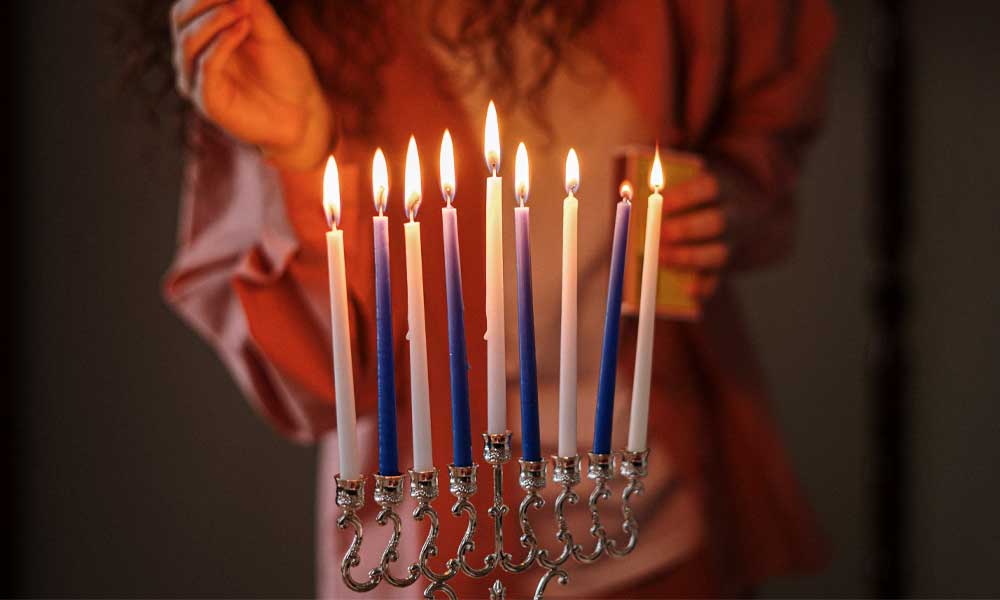
Hanukkah may be a minor religious holiday, but it’s a major cultural holiday. Of course, even that statement can and will be debated—and you’re welcome to do that while I’m over here eating my latkes.
Yes, I understand that my Ashkenazi/American is showing, and it will undoubtedly show itself even more in my playlist. I will try to offer some balance, but there is no question that my cultural perspective is reflected in my choices, and that it is possible to construct a Hanukkah playlist that would be completely different from mine. It also omits the most essential Hanukkah music of all—that which is sung and played live in your house with family and friends. Perhaps the ideal Hanukkah would be devoid of any recorded music, filled only with the songs and dances generated by its participants. But these days it seems no occasion is devoid of technology, and there’s no reason why this holiday should be exempt from that—especially since there is a rich legacy of recorded music that can only add to our understanding of Hanukkah and our connection to its traditions.
Click here for Moment’s Hanukkah Guide with more
Hanukkah Recipes, Stories and Lessons
Haneros Haluli, Herb Steiner
The traditional blessing over the candles has been recorded in many different versions that are so diverse that it may be hard to discern that they’re all based on the same tune. My favorite is one of the first to be recorded: a haunting version for violin and cimbalom recorded in Poland sometime between 1910-1914. The name of the violinist is Herb Steiner.
Maoz Tzur
“Moaz Tzur” is an ancient tune that is represented in many different traditions (including a distinctly non-Jewish one known as “Rock of Ages.”) The Zamir Chorale of Boston sings four versions—as a traditional liturgical rendition with piano, an a cappella chant, and settings by the 18th century Italian composer Benedetto Marcello and the 20th century cantor Hugo Adler.
Judas Maccabaeus, George Frederic Handel
We should be grateful to George Frederic Handel, who thoughtfully supplied us with several Old Testament oratorios as every bit as resplendent as “Messiah,” including a few tailor-made for specific holidays: “Israel in Egypt” for Passover, “Esther” for Purim, and “Judas Maccabaeus” for Hanukkah. In composing the last one, Handel seemed to have been deliberately trying to replicate the structure and feel of “Messiah,” perhaps consciously trying to please the Jewish merchants who made up a large part of his London audience. It worked: While it’s less well known today, it was one of Handel’s most popular works in his lifetime. I’ve chosen three selections from the oratorio’s third and final part. The first is an aria that specifically refers to the holiday ritual: “Father of Heav’n! From Thy eternal throne,/Look with an eye of blessing down,/While we prepare with holy rites,/To solemnize the feasts of lights.” The second is a group of three numbers that celebrate the hero’s triumphant return: the choruses “See the conqu’ring hero comes” and “Sing unto God,” with and instrumental march between them. And the third is Judah’s own aria, “Sound the Alarm,” in a performance by a Jewish hero of more recent times, the legendary tenor Jan Peerce.
Twelve Variations in G major on “See the conqu’ring hero comes” from Handel’s Judas Maccabaeus, Beethoven
If you listened to the previous selections, then the tune that’s still going through your head is “See the conqu’ring hero comes,” which has taken on a life of its own in the last two centuries, but Handel dwells on it all too briefly in the original oratorio. To that end, one of Handel’s biggest fans comes to the rescue: Ludwig van Beethoven. Beethoven considered Handel the greatest composer of all time, even greater than Bach, though by Beethoven’s time both of those Baroque composers were out of fashion. An instrument that was not yet in fashion was the cello; in this work, the first of several that he would write for the combination of cello and piano, he made the case that the cello, like the violin, was capable of holding its own as a solo instrument. Perhaps he chose this tune as a way of heralding three heroes: the cello, which would indeed take on a heroic role in the realm of music; Handel, whose works would be rediscovered and enjoyed by future generations; and Beethoven himself, who, still at the beginning of his career, wanted to let the world know that he was a force to be reckoned with who would single-handedly change the culture.
Drey Dreydele, Moishe Oysher
Moishe Oysher was a cantor, a Yiddish theater actor, a star in several Yiddish films as well as the Hollywood film Singing in the Dark, and, above all, a force of nature. His song “Drey Dreydele” was recorded in 1950 and re-released in 1958 on his album Moishe Oysher Chanukah Party with each song introduced by his 11-year-old daughter Shoshanna. Notice the way the melody and words are constructed so that the voice seems to spin like a dreidel.
Oy Chanukah, Theodore Bikel
The late, great Theodore Bikel sings that unavoidable song “Oy Chanukah” in a way you won’t want to avoid, in both English and Yiddish.
¡O! Que Mueves Mezes, Loren Pomerantz
This lovely Sephardic song is not specifically about Hanukkah, but in its treatment of pregnancy as a wondrous event it’s evocative of the everyday miracles and of children, both important elements of the holiday.
Klaybt Zikh Tsunoyf (Gather Together), Brave Old World
This is another song not specific to Hanukkah, but certainly applicable to any holiday because it reminds us that we’re family—and that ultimately, our similarities are greater than our differences.

One thought on “Songs for Your Hanukkah Playlist”
very helpful article…thanks for sharing this informative post
best regard